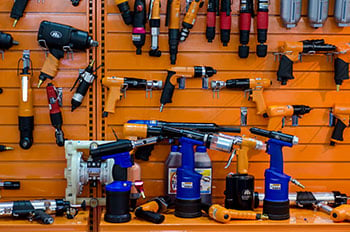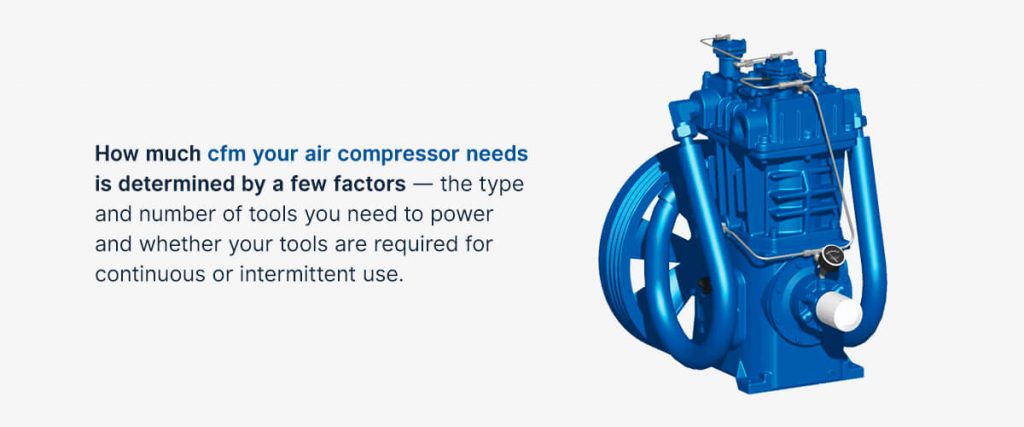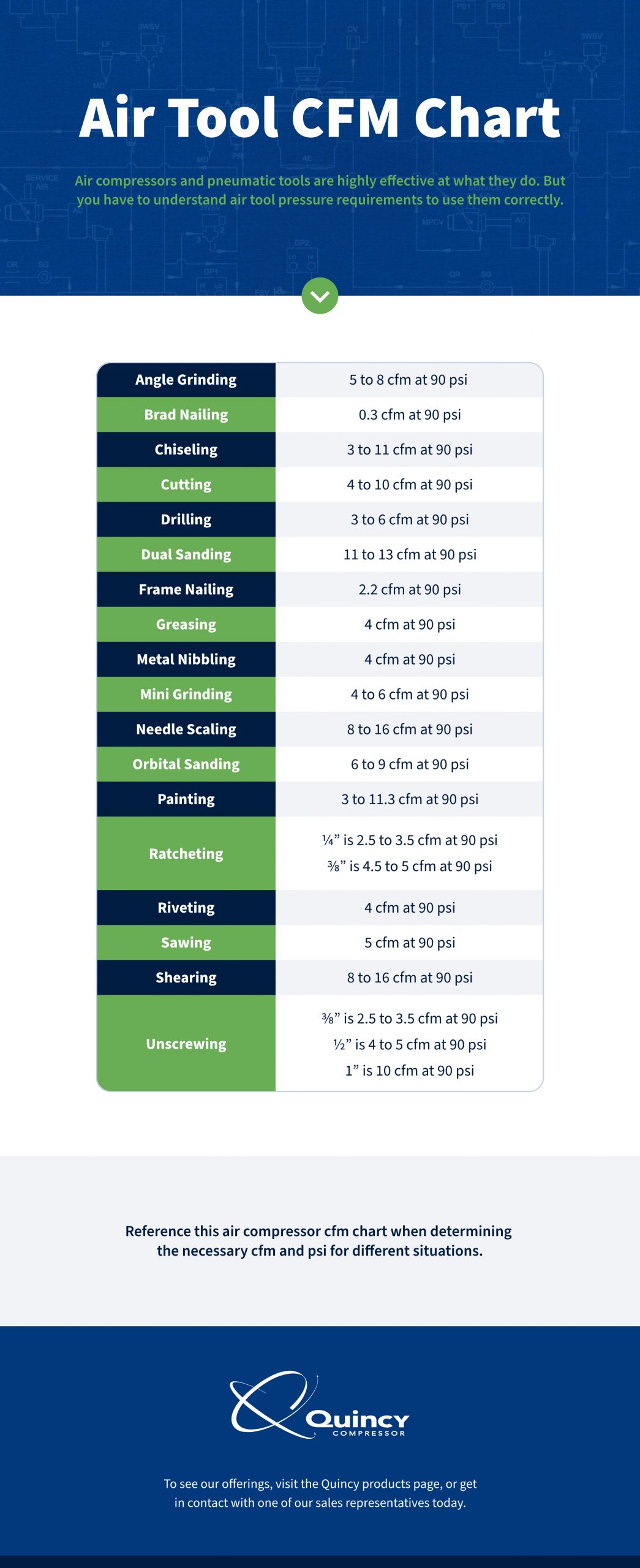To determine CFM for an air compressor, check the air tools’ requirements. Most air tools need 0.5 to 5 CFM at 90 PSI.
Choosing the right air compressor CFM is crucial for efficient tool performance. CFM, or cubic feet per minute, measures the volume of air a compressor delivers. Matching the CFM rating of your air tools ensures they operate effectively. Different tools require varying CFM levels, so it’s essential to know each tool’s specifications.
Common air tools like nail guns and impact wrenches typically need 0. 5 to 5 CFM at 90 PSI. Always consider the highest CFM requirement among your tools to select a suitable air compressor. This approach guarantees optimal performance and longevity for your equipment.

Introduction To Cfm And Air Compressors
Understanding CFM is crucial for choosing the right air compressor. CFM stands for Cubic Feet per Minute. It measures the volume of air the compressor can deliver. Different air tools require different CFM ratings. Knowing your tool’s requirements ensures optimal performance.
Importance Of Cfm
CFM is vital for the efficiency of your air compressor. Higher CFM means more air output. This allows you to run multiple tools simultaneously. Tools like sanders or grinders need high CFM. Lower CFM is sufficient for tools like nail guns. Always check the CFM requirement of your tools. This prevents underperformance and ensures smooth operation.
Basic Air Compressor Functions
An air compressor converts power into potential energy. This energy is stored in pressurized air. The compressor uses a motor to compress air. This air is then released in bursts. Different types of compressors exist. Common types are piston, rotary screw, and centrifugal. Each has unique features and uses.
Here is a simple table for quick reference:
| Tool Type | Required CFM |
|---|---|
| Nail Gun | 2-4 CFM |
| Impact Wrench | 4-6 CFM |
| Paint Sprayer | 6-8 CFM |
| Grinder | 8-12 CFM |
Remember, the right CFM ensures your tools work efficiently. Always match your compressor’s CFM to your tool’s needs. This saves time and increases productivity.
Cfm Requirements For Various Air Tools
Knowing the CFM requirements of your air tools is crucial. It ensures optimal performance and avoids overloading your air compressor. Let’s explore the CFM needs for different air tools.
Common Air Tools
Various air tools have specific CFM ratings. These ratings indicate how much air they need to operate effectively. Below are some common air tools and their typical CFM requirements.
| Air Tool | Typical CFM Requirement |
|---|---|
| Impact Wrench (1/2″) | 4-5 CFM |
| Air Ratchet (3/8″) | 3-4 CFM |
| Paint Sprayer | 6-7 CFM |
| Air Hammer | 4-5 CFM |
| Die Grinder | 5-6 CFM |
Specific Cfm Needs
Each air tool has a unique CFM requirement. Let’s break down the specifics:
- Impact Wrench: This tool needs around 4-5 CFM. It’s used for loosening and tightening nuts and bolts.
- Air Ratchet: Requires 3-4 CFM. Ideal for tightening bolts in hard-to-reach areas.
- Paint Sprayer: Needs about 6-7 CFM. Perfect for achieving a smooth, even paint finish.
- Air Hammer: Uses 4-5 CFM. Effective for chiseling and breaking work.
- Die Grinder: Consumes 5-6 CFM. Suitable for grinding, sanding, and honing tasks.
Understanding these CFM needs ensures your compressor can handle your tools.
How To Calculate Cfm For Your Air Compressor
Determining the correct CFM (Cubic Feet per Minute) for your air compressor is essential. It ensures your air tools work efficiently. Follow these steps to calculate the CFM needed for your air tools.
Steps To Determine Cfm
- Identify the Air Tool: Find out the CFM requirements of your air tool. Check the user manual or the tool’s specifications.
- Check Manufacturer Guidelines: Always refer to the manufacturer’s recommendations. They provide accurate CFM values for their tools.
- Determine Operating Pressure: Look at the PSI (Pounds per Square Inch) required for the tool. It usually ranges between 70-90 PSI.
- Calculate Total CFM: Add up the CFM requirements for all tools you will use simultaneously.
Tools For Calculation
Use these tools to calculate the CFM for your air compressor:
- CFM Calculator: Many online calculators help determine the required CFM. Enter the tool’s CFM and PSI values.
- Manual Calculation: Use a simple formula:
CFM = (Air Consumption / (14.7 / (14.7 + PSI))). This formula considers the tool’s air consumption and operating pressure. - Charts and Tables: Refer to CFM requirement charts. These tables list common air tools and their CFM needs.
| Air Tool | Average CFM | Operating PSI |
|---|---|---|
| Impact Wrench | 4-5 | 90 |
| Air Drill | 3-4 | 90 |
| Paint Sprayer | 6-7 | 40 |
By following these steps, you can accurately determine the CFM needed. This ensures your air compressor meets your tools’ requirements.

Factors Affecting Cfm In Air Compressors
Understanding the factors affecting CFM in air compressors is crucial for selecting the right equipment. CFM, or Cubic Feet per Minute, measures the volume of air delivered by the compressor. Different factors influence this value, including pressure, volume, and environmental conditions. Below, we explore these factors in detail.
Pressure And Volume
The pressure of an air compressor, measured in PSI (pounds per square inch), directly impacts the CFM. Higher pressure typically reduces CFM, while lower pressure increases it. Balancing pressure and volume is essential for efficient operation.
| Pressure (PSI) | CFM Output |
|---|---|
| 90 PSI | 5 CFM |
| 150 PSI | 3 CFM |
Volume, or the tank size, also plays a role. A larger tank can store more air, offering higher CFM over longer periods. This is vital for tools requiring continuous airflow.
Environmental Considerations
Environmental factors such as temperature and humidity can affect CFM. Cold temperatures reduce air density, decreasing CFM. Conversely, hot temperatures increase air density, boosting CFM.
- High humidity can cause moisture build-up, impacting air quality and compressor efficiency.
- Keeping the compressor in a controlled environment ensures consistent performance.
Proper ventilation and regular maintenance can help mitigate these environmental impacts. Ensuring the compressor operates in optimal conditions will maintain its efficiency and longevity.
Choosing The Right Air Compressor
Choosing the right air compressor can be difficult. It’s essential to understand your needs. This ensures the best performance for your tools.
Types Of Air Compressors
There are various types of air compressors. Each has its unique features. Here are the common types:
- Reciprocating Air Compressors: These are piston-driven.
- Rotary screw compressors: These use screws to compress air.
- Centrifugal Compressors: These rely on a rotating impeller.
| Compressor Type | Best For | Key Features |
|---|---|---|
| Reciprocating | Home Use | Portable, High Pressure |
| Rotary Screw | Industrial Use | Continuous Operation, High Output |
| Centrifugal | Large Scale | High Capacity, Efficient |
Matching Cfm To Tools
CFM stands for Cubic Feet per Minute. It measures the air output of a compressor. Different tools need different CFM levels.
Here’s how to match CFM to your tools:
- Identify the tool’s CFM requirement.
- Check the compressor’s CFM rating.
- Ensure the compressor meets or exceeds the tool’s CFM.
Below is a quick reference for common tools:
| Tool | Average CFM |
|---|---|
| Impact Wrench | 2-4 CFM |
| Paint Sprayer | 6-7 CFM |
| Sandblaster | 10-15 CFM |

Maintaining Optimal Cfm
Maintaining optimal CFM (Cubic Feet per Minute) for your air compressor is crucial. It ensures efficiency and longevity of both your compressor and air tools. Follow these steps to keep your air compressor running smoothly.
Regular Maintenance tips
Performing regular maintenance helps keep your air compressor in top shape. Here are some essential tips:
- Check the air filter: Clean or replace the air filter regularly to prevent clogs.
- Inspect for leaks: Leaks can reduce CFM. Use soapy water to find leaks.
- Drain the tank: Moisture build-up can cause rust. Drain the tank daily.
- Lubricate moving parts: Keep parts well-lubricated to reduce wear and tear.
- Monitor pressure levels: Ensure the pressure gauge is accurate and calibrated.
Troubleshooting Low Cfm
Experiencing low CFM can hinder your work efficiency. Follow these troubleshooting steps:
- Check for air leaks: Even small leaks can drop CFM significantly.
- Inspect the air filter: A dirty filter can restrict airflow.
- Examine the hose: Ensure the hose is not kinked or damaged.
- Evaluate the compressor size: Ensure the compressor matches your tool’s CFM needs.
- Test the regulator: The regulator might need adjustment or replacement.
Keeping an eye on these factors ensures your air compressor maintains optimal CFM. This guarantees efficient performance and extends the life of your tools.
Upgrading Your Air Compressor For Better Cfm
Upgrading your air compressor can significantly enhance its performance. A better CFM (cubic feet per minute) rating is crucial for running multiple air tools. This guide will help you understand the benefits and the right time to upgrade.
When To Upgrade
Knowing when to upgrade your air compressor is vital. You should consider an upgrade if:
- Your current air compressor struggles to keep up with your tools.
- You plan to use multiple air tools simultaneously.
- The CFM requirement of your tools exceeds your compressor’s capacity.
- Your projects are taking longer due to low air pressure.
Benefits Of Upgrading
Upgrading your air compressor comes with numerous benefits, including:
| Benefit | Explanation |
|---|---|
| Increased Efficiency | Higher CFM allows your tools to run smoothly. |
| Better Performance | Your projects will be completed faster. |
| Longevity | Less strain on the compressor means a longer lifespan. |
| Versatility | You can use a wider range of tools. |
Efficiency is key for any project. Upgrading your air compressor ensures you can handle any task. You will notice a significant improvement in your workflow.
Safety Tips For Using Air Tools
Air tools are powerful and efficient. They can make tasks easier. But they can also be dangerous. Following safety tips is crucial. Here are some important tips to keep safe.
Proper Handling
Always read the user manual. Understand how the tool works. Never point the tool at yourself or others. Ensure the tool is off before connecting it to the compressor.
Use the right tool for the job. Avoid using damaged tools. Regularly inspect tools for wear and tear. Keep your workspace clean and organized.
Protective Gear
Wear safety goggles to protect your eyes. Use ear protection to guard against loud noises. Gloves can protect your hands from injuries.
Consider wearing a dust mask. It helps in avoiding inhaling particles. Ensure you have steel-toed boots. They protect your feet from heavy objects.
| Protective Gear | Purpose |
|---|---|
| Safety Goggles | Protects eyes from debris |
| Ear Protection | Guards against loud noises |
| Gloves | Protects hands from injuries |
| Dust Mask | Prevents inhalation of particles |
| Steel-toed Boots | Protects feet from heavy objects |
- Inspect tools regularly
- Keep workspace clean
- Use tools as intended
- Read the manual
- Wear protective gear
- Inspect tools before use
Frequently Asked Questions
What Is Cfm In Air Compressors?
CFM stands for Cubic Feet per Minute. It measures the volume of air an air compressor delivers.
How To Calculate Cfm For Air Tools?
To calculate CFM, check your tool’s manual. Add 30-50% extra CFM to ensure efficiency.
How Much Cfm Is Needed For Air Tools?
Most air tools require 0. 5 to 5 CFM. High-demand tools may need more.
Why Is Cfm Important For Air Compressors?
CFM determines the air tool’s performance. Insufficient CFM can lead to poor tool efficiency.
Conclusion
Determining the right CFM for your air compressor is crucial. It ensures optimal performance of your air tools. Always consider the tool requirements and compressor capabilities. Proper calculation prevents inefficiency and damage. Take the time to assess your needs, and you’ll achieve seamless and effective operation.

